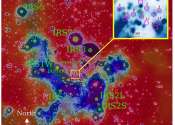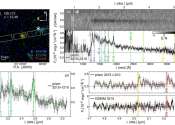The density difference of sub-Neptunes finally deciphered
An international team led by UNIGE, UNIBE and PlanetS has shown the existence of two distinct populations of sub-Neptunes, resolving a debate in the scientific community.
Astronomy and Astrophysics is a peer-reviewed scientific journal covering theoretical, observational and instrumental astronomy and astrophysics. It was published by Springer-Verlag from 1969–2000, while EDP Sciences published the companion A Supplement Series. In 2000, the two journals merged, with the combined journal known simply as Astronomy and Astrophysics and published by EDP Sciences. The journal copyright is owned by the European Southern Observatory. Astronomy and Astrophysics was formed in 1969 by the merging of several national journals of individual European countries. These journals, with their ISSN and date of first publication are as follows: The publishing of Astronomy and Astrophysics was further extended in 1992 by the incorporation of Bulletin of the Astronomical Institutes of Czechoslovakia, established in 1947. The original sponsoring countries were the four countries whose journals merged to form Astronomy and Astrophysics (France, Germany, the Netherlands and Sweden), together with Belgium, Denmark, Finland, and Norway. The European Southern Observatory also participated as a "member country". Norway later withdrew, but Austria, Greece, Italy, Spain, and

An international team led by UNIGE, UNIBE and PlanetS has shown the existence of two distinct populations of sub-Neptunes, resolving a debate in the scientific community.
Astronomy
Jun 27, 2024
0
35

Supermassive black holes pose unanswered questions for astronomers around the world, not the least of which is "How do they grow so big?" Now, an international team of astronomers, including researchers from Chalmers University ...
Astronomy
Jun 20, 2024
0
87

Photographing faint objects close to bright stars is incredibly difficult. Yet, by combining data from ESA's Gaia space telescope with ESO's GRAVITY instrument on the ground, scientists managed just that. They took the first ...
Astronomy
Jun 20, 2024
0
325

In late 2019, the previously unremarkable galaxy SDSS1335+0728 suddenly started shining brighter than ever before. To understand why, astronomers have used data from several space and ground-based observatories, including ...
Astronomy
Jun 18, 2024
0
154

Observational astronomy shows that newly discovered young stellar objects (YSOs) in the immediate vicinity of the supermassive black hole Sagittarius A* located in the center of our galaxy behave differently than expected. ...
Astronomy
Jun 14, 2024
5
524

"Classical Cepheids" are a type of pulsating star that rhythmically brighten and dim over time. These pulsations help astronomers measure vast distances across space, which makes Cepheids crucial "standard candles" that help ...
Astronomy
Jun 14, 2024
0
396

SRON astronomers have for the first time mapped the outflows from one of the closest quasars to Earth. Quasars are bright cores of galaxies powered by the supermassive black hole in their center. The team has probed gas outflows ...
Astronomy
Jun 11, 2024
0
302

Westerlund 1 is the biggest and closest "super" star cluster to Earth. New data from NASA's Chandra X-ray Observatory, in combination with other NASA telescopes, is helping astronomers delve deeper into this galactic factory ...
Astronomy
Jun 10, 2024
0
61

Astronomers have detected carbon in a galaxy just 350 million years after the Big Bang, the earliest detection of any element in the universe other than hydrogen.
Astronomy
Jun 6, 2024
1
175

Contrary to what is established by the standard model, dark matter may indeed be self-interacting. This was the conclusion of a piece of research published in Astronomy & Astrophysics and conducted by Riccardo Valdarnini ...
Astronomy
May 31, 2024
0
179